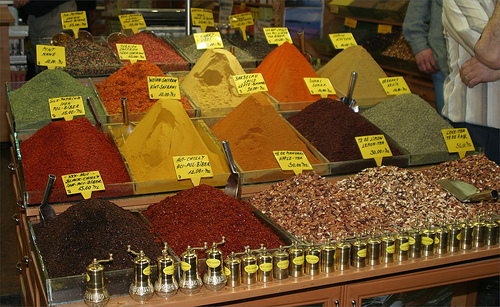[Today is a guest post from Andrew Hall at the Apple a Day blog.]
While it’s important to salt foods in order to bring out their true flavor, salt is not the only way to add a little oomph to your cooking. Bring some ethnic flavor to everyday meals with these commonly-used spices.
Simple to incorporate and readily available at any grocery stores, these spices are the perfect starters for your foray into ethnically-inspired cuisine.
1. Chili powders
 Chili powders are hugely diverse and can be made up of many ingredients, but always have a pepper ground to a powder at its core, such as ancho, Cayenne pepper, or Jalapeño chilis, but also oregano, garlic powder, and nutmeg, among other things.
Chili powders are hugely diverse and can be made up of many ingredients, but always have a pepper ground to a powder at its core, such as ancho, Cayenne pepper, or Jalapeño chilis, but also oregano, garlic powder, and nutmeg, among other things.
Chili powders get used not just to make dishes like chili, but also become the bases of foods like kimchi, pickled Korean cabbage. They often come in red and black colors and add heat and depth to virtually any dish, depending on the chiles used and the cuisine being cooked.
2. Ginger root
 Ginger has a distinct flavor all its own, offering both heat and a distinct, pungent, spicy-sweet taste. It can be made into tea or candy, but also serves (in its pickled form) as a core component of sushi.
Ginger has a distinct flavor all its own, offering both heat and a distinct, pungent, spicy-sweet taste. It can be made into tea or candy, but also serves (in its pickled form) as a core component of sushi.
It is prominent in many Japanese, Chinese, Indian and Thai dishes, where it seasons meat and vegetables in tandem with other spices, and can be made into foods like ginger scallion sauce, which highlight ginger’s intense raw flavor without being overbearing.
3. Turmeric
This South Asian plant tastes of earth and is slightly bitter, but is known more than anything else for giving standardized Indian curry powder its distinct yellow appearance (and staining kitchen work surfaces, which it’s also very good at).
Turmeric, in its powdered form, serves as part of many Indian curry powders and mustards, but also exists in cosmetics and even as a fabric dye.
4. Cumin
Cumin seed is among the most popular spices in the world, appearing in some European breads and cheeses, Mexican chili powders, and many African, Asian, and Middle Eastern cuisines.
Toasted cumin seed is a core component of standardized curry powder, but it also works well in many stews and soups, adding earthy flavors and a warmth distinct from that of pepper to the food item.

Photo by exfordy / Brian Snelson
5. Coriander
Coriander seed has a citrus flavor reminiscent of lemons, providing warmth and hints of fruit to a dish. The seeds lose flavor quickly after being ground, which is why freshly made curry powders carry considerably better flavors than the standardized ones often sold in huge quantities in supermarkets.
It appears prominently alongside cumin in dishes like curry and garam masala, but also can appear in beer, in bread, and as an aid to pickling vegetables.
6. Nutmeg
Nutmeg is a sweet spice used ground in a surprisingly diverse number of dishes. It appears in savory meals in Greek, Middle Eastern and Indian cooking, in Japanese curry powders, in European desserts such as mulled wine, cider and eggnog, and as a garnish in cocktails like the Bushwacker and the Brandy Alexander.
To maintain its flavor, it is often ground right before cooking and served fresh.
Andrew Hall is a guest blogger for An Apple a Day and a writer on the subject of becoming a medical transcriptionist for the Guide to Health Education.











